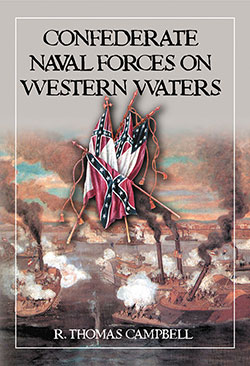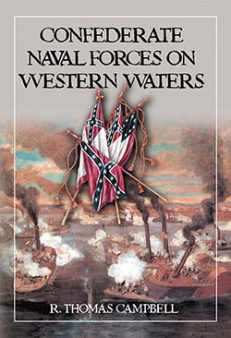Confederate Naval Forces on Western Waters
The Defense of the Mississippi River and Its Tributaries
$39.95
In stock
About the Book
No body of water was more vital to the Confederacy’s efforts in the Civil War than the Mississippi River and its tributaries. Though the Confederate Congress declared the Mississippi free and open to all states north and south, the Union launched plans for an effective blockade of the 1700 miles of Southern coastline, coupled with a strong naval and army thrust down the Mississippi Valley from Cairo, Illinois, to the Gulf of Mexico. To defend the river and to prevent Union forces from advancing, the South would require a strong naval force. There was only one problem with the strategy: The Confederacy had no navy.
On February 25, 1861, Confederate president Jefferson Davis nominated Stephen R. Mallory to be secretary of the newly formed Confederate States Navy. Mallory faced significant obstacles—no shipyards, few skilled craftsmen and machinists, and a lack of production facilities to process raw materials. Mallory was able to overcome the many shortcomings to build a formidable navy, but the efforts in the Mississippi theater were hamstrung by a disjointed command structure and interservice bickering. Despite these problems, the Confederate Navy contested the Union forces at every turn. The history of Confederate naval forces on the western waters is a story of desperation, intrigue, ineptitude, and humiliating defeats, interspersed with moments of courage, innovation, resourcefulness, and a few hard-earned victories.
About the Author(s)
Bibliographic Details
R. Thomas Campbell
Format: softcover (7 x 10)
Pages: 280
Bibliographic Info: 180 photos, maps, appendices, notes, bibliography, index
Copyright Date: 2011 [2005]
pISBN: 978-0-7864-6417-3
eISBN: 978-1-4766-0437-4
Imprint: McFarland
Table of Contents
Table of Contents
Acknowledgments v
Introduction 1
1. The Gathering Clouds 5
2. Victory at the Head of the Passes 23
3. Island Number 10 36
4. Building the Ironclads 52
5. The Battle of New Orleans 66
6. Plum Point, the Battle of Memphis, and the White River Campaign 83
7. Building the CSS Arkansas 103
8. Into the Volcano 120
9. Berwick Bay and the J.A. Cotton 141
10. Gunfire at Galveston 152
11. Action on the Tributaries. 169
12. The Pursuit and Destruction of the USS Indianola 185
13. The CSS Missouri and the Loss of Yazoo City 195
14. The CSS Webb and the Final Surrender 208
15. Some Final Thoughts 220
Appendices
A. Officers Assigned to the CSS Sumter 223
B. Fight at the Head of the Passes: Extract from the New Orleans Daily True Delta, October 15, 1861 224
C. Log of the General Sterling Price, March 25, 1862, to June 5, 1862 226
D. The Ram Manassas at the Passage of the New Orleans Forts 230
E. Report of Brigadier-General Thompson, Missouri State Guards 233
F. Montgomery and Thompson’s Reports of the Battle of Plum Point 235
G. Officers Assigned to the CSS Arkansas 238
H. CS Gunboat J.A. Cotton Burnt: Extract from the Houston Tri-Weekly Telegraph, February 2, 1863 240
I. The Agony of Major Lea: Extract from a Texas Newspaper, January 1863 243
J. Report of Lieutenant Commander Selfridge, U.S. Navy, Late Commanding USS Cairo 245
K. Report of Lieutenant Commander Brown, U.S. Navy, Regarding the Loss of the USS Indianola 247
L. Report of Lieutenant Colonel Creasman, C.S. Army, Commanding at Yazoo City 251
M. Officers of the CSS Webb, April 1865 254
N. Federal Survey of the CSS Missouri 255
Chapter Notes 259
Bibliography 265
Index 267
Book Reviews & Awards
“highly readable…writing is always crisp and clear…very well illustrated…excellent work…highly recommended”—The Civil War News; “well written”—The Nymas Review; “Campbell paints a picture of naval combat vital to the Confederate war effort”—H-Net Reviews.





